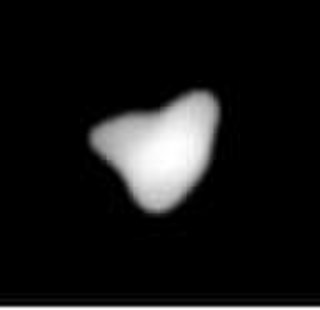
Urania is a large main-belt asteroid that was discovered by English astronomer John Russell Hind on July 22, 1854. It was his last asteroid discovery. This object is named after Urania, the Greek Muse of astronomy. Initial orbital elements for 30 Urania were published by Wilhelm Günther, an assistant at Breslau Observatory. It is orbiting the Sun with a period of 3.64 years and is spinning on its axis once every 13.7 hours.

Leda is a large, dark main-belt asteroid that was discovered by French astronomer J. Chacornac on January 12, 1856, and named after Leda, the mother of Helen of Troy in Greek mythology. In the Tholen classification system, it is categorized as a carbonaceous C-type asteroid, while the Bus asteroid taxonomy system lists it as a Cgh asteroid. The spectra of the asteroid displays evidence of aqueous alteration.

Klotho is a fairly large main-belt asteroid. While it is an M-type, its radar albedo is too low to allow a nickel-iron composition. Klotho is similar to 21 Lutetia and 22 Kalliope in that all three are M-types of unknown composition. Klotho was found by Ernst Tempel on February 17, 1868. It was his fifth and final asteroid discovery. It is named after Klotho or Clotho, one of the three Moirai, or Fates, in Greek mythology.

Dike is a quite large and dark main-belt asteroid. Dike was discovered by Alphonse Borrelly on May 28, 1868. It was his first asteroid discovery. This object is named after Dike, the Greek goddess of moral justice. Among the first hundred numbered minor planets, 99 Dike was considered anomalously faint for over a century. However, this was later found to be untrue.
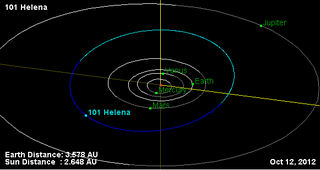
Helena is a large, rocky main-belt asteroid. It was discovered by Canadian-American astronomer J. C. Watson on August 15, 1868, and was named after Helen of Troy in Greek mythology.
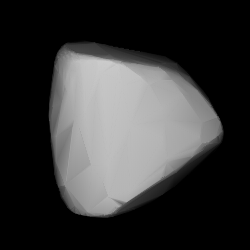
Hera is a moderately large main-belt asteroid with an orbital period of 4.44 years. It was discovered by Canadian-American astronomer James Craig Watson on September 7, 1868, and named after Hera, queen and fifth in power of the Olympian gods in Greek mythology. This is a stony S-type asteroid with a silicate surface composition.

Artemis is a main-belt asteroid that was discovered by J. C. Watson on September 16, 1868, at Ann Arbor, Michigan. It was named after Artemis, the goddess of the hunt, Moon, and crossways in Greek Mythology.
Dione is a large main-belt asteroid. It probably has a composition similar to 1 Ceres. It was discovered by J. C. Watson on October 10, 1868, and named after Dione, a Titaness in Greek mythology who was sometimes said to have been the mother of Aphrodite, the Greek goddess of love and beauty. It is listed as a member of the Hecuba group of asteroids that orbit near the 2:1 mean-motion resonance with Jupiter. The orbital period for this object is 5.66 years and it has an eccentricity of 0.17.

Lydia is a large belt asteroid with an M-type spectrum, and thus may be metallic in composition, consisting primarily of nickel-iron. It was discovered by French astronomer Alphonse Borrelly on 19 April 1870 and was named for Lydia, the Asia Minor country populated by Phrygians. The Lydia family of asteroids is named after it.
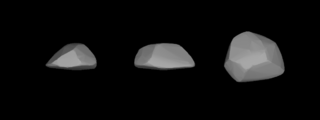
Althaea is a main-belt asteroid that was discovered by Canadian-American astronomer J. C. Watson on April 3, 1872, and named after Althaea, the mother of Meleager in Greek mythology. Two occultations by Althaea were observed in 2002, only a month apart.

Vala is an inner main-belt asteroid. It was discovered by C. H. F. Peters on 24 May 1873, and derives its name from völva, a prophetess in Norse paganism. One observation of an occultation of a star by Vala is from Italy. 10-μm radiometric data collected from Kitt Peak in 1975 gave a diameter estimate of 34 km.

Cyrene, minor planet designation 133 Cyrene, is a fairly large and very bright main-belt asteroid that was discovered by J. C. Watson on 16 August 1873 in Ann Arbor, Michigan, and named after Cyrene, a nymph, daughter of king Hypseus and beloved of Apollo in Greek mythology. It is classified as an S-type asteroid based upon its spectrum. It is listed as a member of the Hecuba group of asteroids that orbit near the 2:1 mean-motion resonance with Jupiter.
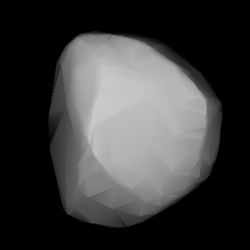
Nuwa is a large main-belt asteroid with an orbital period of 5.15 years. It was discovered by Canadian-American astronomer James Craig Watson on October 18, 1875, and named after Nüwa, the Chinese creator goddess. This object is a candidate member of the Hecuba group of asteroids that orbit near the 2:1 mean-motion resonance with Jupiter. Based upon the spectrum it is classified as a C-type asteroid, which indicates that it is probably composed of primitive carbonaceous chondritic material and the surface is exceedingly dark.

Koronis is a main-belt asteroid that was discovered by Russian astronomer Viktor Knorre on January 4, 1876, from the Berlin observatory. It was the first of his four asteroid discoveries. The meaning of the asteroid name is uncertain, but it may come from Coronis the mother of Asclepius from Greek mythology. Alternatively, it may come from Coronis, a nymph of the Hyades sisterhood. The Koronis family is named after this asteroid.

Una is a fairly large and dark, primitive Main belt asteroid that was discovered by German-American astronomer C. H. F. Peters on February 20, 1876, in Clinton, New York. It is named after a character in Edmund Spenser's epic poem The Faerie Queene (1590).

Maria is a Main belt asteroid that was discovered by French astronomer Henri Joseph Perrotin on January 10, 1877. Its orbit was computed by Antonio Abetti, and the asteroid was named after his sister, Maria. This is the namesake of the Maria asteroid family; one of the first asteroid families to be identified by Japanese astronomer Kiyotsugu Hirayama in 1918.

Eucharis is a large, slowly rotating main-belt asteroid that was discovered by French astronomer Pablo Cottenot on February 2, 1878, from Marseille Observatory. It was his only asteroid discovery. This object was named after Eucharis, a nymph from the 17th-century novel Les Aventures de Télémaque.

706 Hirundo is an elongated background asteroid, located in the central region of the asteroid belt. It was discovered by German astronomer Joseph Helffrich at the Heidelberg Observatory on 9 October 1910. The carbonaceous C-type asteroid (Cgh) has a rotation period of 22.0 hours and measures approximately 30 kilometers in diameter. It was named after the bird genus Hirundo, commonly known as swallows.
716 Berkeley is a background asteroid from the central regions of the asteroid belt. It was discovered by Austrian astronomer Johann Palisa at the Vienna Observatory on 30 July 1911. The stony S-type asteroid has a rotation period of 15.6 hours and measures approximately 21 kilometers in diameter. It was named after the city of Berkeley, California, where the discoverer's colleague Armin Otto Leuschner (1868–1953) was the director of the local observatory.

908 Buda is a background asteroid from the inner regions of the asteroid belt, approximately 30 kilometers in diameter. It was discovered by German astronomer Max Wolf at the Heidelberg Observatory on 30 November 1918. The uncommon L-type asteroid has a rotation period of 14.6 hours. It was named after Buda, the smaller part of the Hungarian city of Budapest.


















